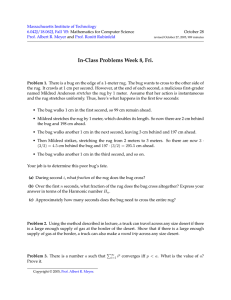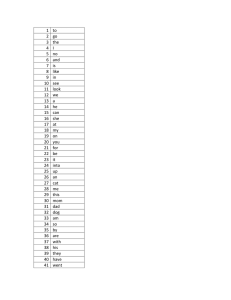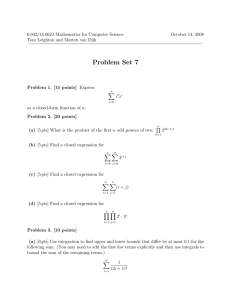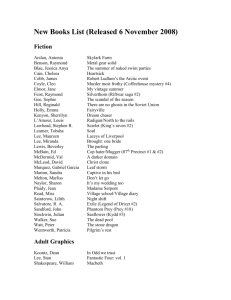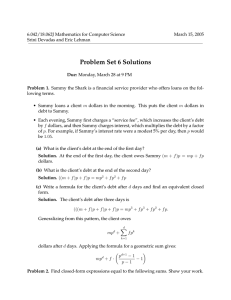Massachusetts Institute of Technology 6.042J/18.062J, Fall ’05 Prof. Albert R. Meyer
advertisement
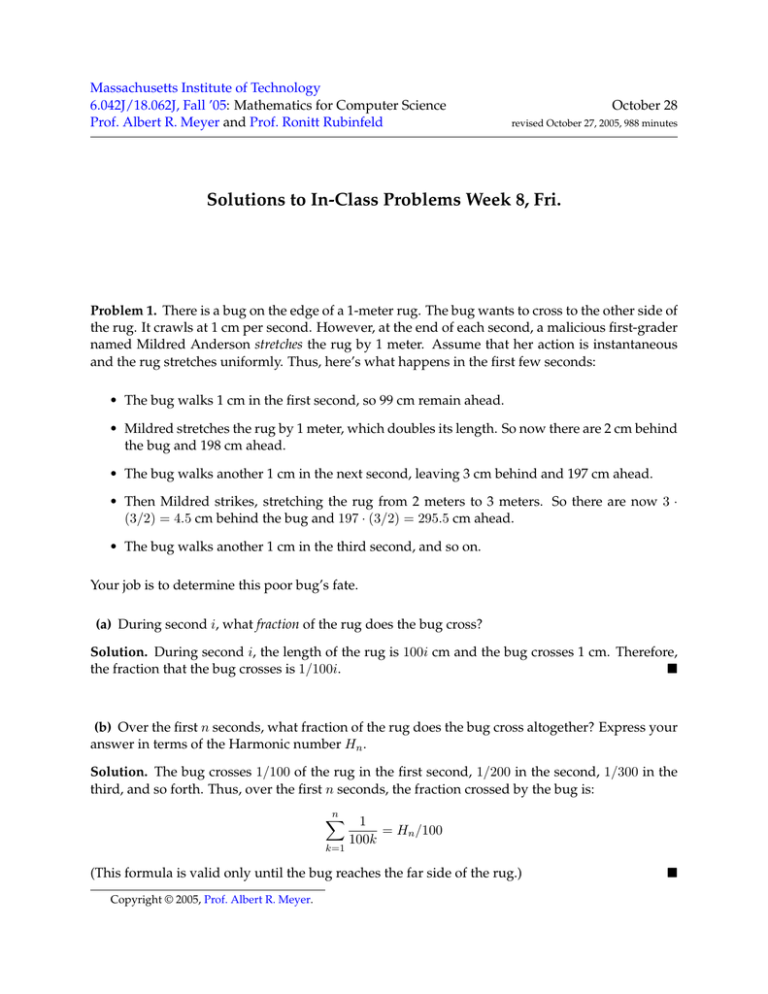
Massachusetts Institute of Technology 6.042J/18.062J, Fall ’05: Mathematics for Computer Science Prof. Albert R. Meyer and Prof. Ronitt Rubinfeld October 28 revised October 27, 2005, 988 minutes Solutions to In­Class Problems Week 8, Fri. Problem 1. There is a bug on the edge of a 1­meter rug. The bug wants to cross to the other side of the rug. It crawls at 1 cm per second. However, at the end of each second, a malicious first­grader named Mildred Anderson stretches the rug by 1 meter. Assume that her action is instantaneous and the rug stretches uniformly. Thus, here’s what happens in the first few seconds: • The bug walks 1 cm in the first second, so 99 cm remain ahead. • Mildred stretches the rug by 1 meter, which doubles its length. So now there are 2 cm behind the bug and 198 cm ahead. • The bug walks another 1 cm in the next second, leaving 3 cm behind and 197 cm ahead. • Then Mildred strikes, stretching the rug from 2 meters to 3 meters. So there are now 3 · (3/2) = 4.5 cm behind the bug and 197 · (3/2) = 295.5 cm ahead. • The bug walks another 1 cm in the third second, and so on. Your job is to determine this poor bug’s fate. (a) During second i, what fraction of the rug does the bug cross? Solution. During second i, the length of the rug is 100i cm and the bug crosses 1 cm. Therefore, the fraction that the bug crosses is 1/100i. � (b) Over the first n seconds, what fraction of the rug does the bug cross altogether? Express your answer in terms of the Harmonic number Hn . Solution. The bug crosses 1/100 of the rug in the first second, 1/200 in the second, 1/300 in the third, and so forth. Thus, over the first n seconds, the fraction crossed by the bug is: n � k=1 1 = Hn /100 100k (This formula is valid only until the bug reaches the far side of the rug.) Copyright © 2005, Prof. Albert R. Meyer. � 2 Solutions to In­Class Problems Week 8, Fri. (c) Approximately how many seconds does the bug need to cross the entire rug? Solution. The bug arrives at the far side when the fraction it has crossed reaches 1. This occurs when n, the number of seconds elapsed, is sufficiently large that Hn /100 ≥ 1. Now Hn is approx­ imately ln n, so the bug arrives about when: ln n ≥1 100 ln n ≥ 100 n ≥ e100 ≈ 1043 seconds � Problem 2. Using the method described in lecture, a truck can travel across any size desert if there is a large enough supply of gas at the border of the desert. Show that if there is a large enough supply of gas at the border, a truck can also make a round trip across any size desert. Solution. Given that it can make a one­way trip across any desert, it can make a two­way trip by executing the one­way strategy for twice the desert width, but turning around when it gets to the desert edge instead of continuing. A considerably more efficient approach uses ideas similar to the one­way crossing strategy: let Rn be the distance a truck can travel into the desert and return on n tanks of gas. Clearly, R1 = 1/2. On n + 1 tanks, the strategy is to have truck travel distance x and back n times, leaving 1 − 2x tanks of gas at distance x into the desert on each trip. It then makes one more one­way trip to x. This leaves it with n(1 − 2x) + 1 − x tanks of gas at position x. Leaving an xth of a tank so it can get back, if the remaining (n(1 − 2x) + 1 − x) − x = (n + 1)(1 − 2x) tanks equal n, it can execute the n­tank round trip strategy from position x and still return to the desert border. So, letting (n + 1)(1 − 2x) = n (1) x = 1/2(n + 1) Rn+1 = Rn + x = Rn + 1/2(n + 1). (2) (3) Therefore, Rn = 1/2(1 + 1/2 + 1/3 + · · · + 1/n) = Hn /2. � Problem 3. There is a number a such that Prove it. �∞ p i=1 i converges iff p < a. What is the value of a? Solutions to In­Class Problems Week 8, Fri. 3 Solution. a = −1. For p = −1, the sum is the harmonic series which we know does not converge. Since the term ip is increasing in p for i > 1, the sum will be larger, and hence also diverge for p > −1. By the integral method, the sum is Θ of the integral from 1 to ∞ of xp . For p < −1, the indefinite integral is xp+1 /(p + 1) = Θ(1/x� ) for � = −1 − p > 0, so the integral evaluates to a constant. Hence the sum is bounded above, and since it is increasing, it has a finite limit, i.e., it converges. �
